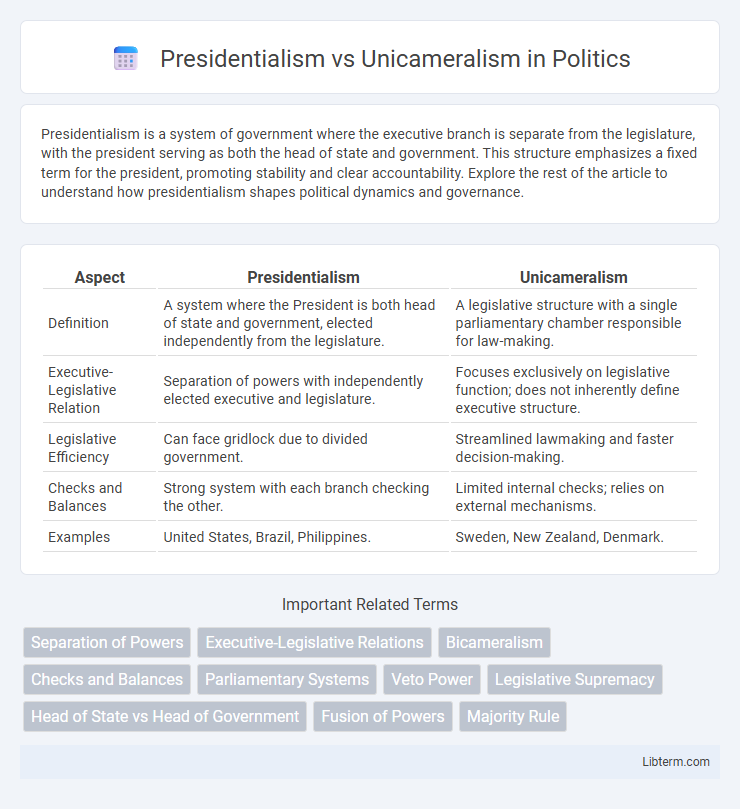Presidentialism is a system of government where the executive branch is separate from the legislature, with the president serving as both the head of state and government. This structure emphasizes a fixed term for the president, promoting stability and clear accountability. Explore the rest of the article to understand how presidentialism shapes political dynamics and governance.
Table of Comparison
| Aspect | Presidentialism | Unicameralism |
|---|---|---|
| Definition | A system where the President is both head of state and government, elected independently from the legislature. | A legislative structure with a single parliamentary chamber responsible for law-making. |
| Executive-Legislative Relation | Separation of powers with independently elected executive and legislature. | Focuses exclusively on legislative function; does not inherently define executive structure. |
| Legislative Efficiency | Can face gridlock due to divided government. | Streamlined lawmaking and faster decision-making. |
| Checks and Balances | Strong system with each branch checking the other. | Limited internal checks; relies on external mechanisms. |
| Examples | United States, Brazil, Philippines. | Sweden, New Zealand, Denmark. |
Understanding Presidentialism: Key Features
Presidentialism features a distinct separation of powers with an independently elected president serving as both head of state and government, ensuring centralized executive authority. This system promotes fixed terms for presidents, enhancing political stability and accountability, unlike parliamentary systems where governments can be dismissed via confidence votes. Understanding presidentialism requires emphasis on its key attributes: direct presidential elections, centralized executive power, and constitutionally defined checks and balances to prevent authoritarianism.
Defining Unicameralism: Structure and Function
Unicameralism refers to a legislative system with a single parliamentary chamber responsible for enacting laws, as opposed to bicameral systems with two separate chambers. This streamlined structure facilitates faster decision-making and reduces legislative redundancy, enhancing efficiency in policy implementation. The unicameral legislature concentrates political power, often leading to more direct accountability and clearer legislative authority within a presidential or parliamentary framework.
Historical Origins of Presidentialism and Unicameralism
Presidentialism traces its origins to the United States Constitution of 1787, where a distinct separation of powers established an independent executive branch led by a president elected separately from the legislature. Unicameralism, historically rooted in simpler governance structures like those in early colonial America and Nordic countries, emerged as a streamlined legislative model emphasizing efficiency and direct representation. Both systems evolved from differing political philosophies, with presidentialism favoring checks and balances and unicameralism prioritizing legislative simplicity and reduced bureaucracy.
Comparative Analysis: Presidential vs Unicameral Governance
Presidentialism features a separate executive branch led by a president who holds significant authority, contrasting with unicameral governance where a single legislative chamber centralizes lawmaking power. Presidential systems promote checks and balances through executive-legislative separation, while unicameral systems emphasize streamlined decision-making with fewer institutional divisions. Comparative analysis reveals presidentialism's potential for political stability alongside challenges of divided government, whereas unicameralism offers efficiency but risks limited representation and oversight.
Democratic Stability: Presidentialism vs Unicameral Systems
Presidentialism, characterized by a separate executive branch elected independently from the legislature, contrasts with unicameralism, where a single legislative chamber holds law-making authority, impacting democratic stability differently. Presidential systems often face challenges due to potential executive-legislative conflicts and gridlock, whereas unicameral systems streamline legislative processes but risk insufficient checks and balances. Empirical studies suggest that democratic stability correlates more closely with institutional design effectiveness and political culture than with the mere presence of presidentialism or unicameralism.
Decision-Making Efficiency: A Structural Perspective
Presidentialism, characterized by a clear separation of powers, often faces challenges in decision-making efficiency due to potential executive-legislative gridlock. Unicameralism streamlines the legislative process by consolidating lawmaking into a single chamber, reducing procedural delays and enhancing swift policy implementation. Structural factors such as concentrated authority in unicameral systems facilitate faster decisions compared to the dispersed power dynamic in presidential systems.
Representation and Accountability in Both Systems
Presidentialism features a separation of powers where the executive is independently elected, enhancing direct accountability to voters but sometimes complicating legislative cooperation. Unicameralism consolidates legislative authority into a single chamber, streamlining decision-making and fostering clearer representation of the electorate's preferences. Both systems balance representation and accountability differently: presidentialism emphasizes executive independence and voter choice, while unicameralism prioritizes legislative cohesion and efficient responsiveness.
Risks and Challenges: Presidentialism and Unicameralism
Presidentialism faces risks such as executive-legislative deadlock and concentration of power, which can undermine democratic accountability and stability. Unicameralism may limit checks and balances by consolidating legislative authority in a single chamber, increasing the risk of rushed or poorly scrutinized legislation. Both systems require robust institutional frameworks and effective mechanisms to mitigate risks of authoritarianism and governance inefficiencies.
Case Studies: Countries Practicing Each System
The United States exemplifies presidentialism with a clear separation of executive and legislative powers, featuring a bicameral Congress that balances power between the Senate and House of Representatives. In contrast, countries like Sweden and New Zealand practice unicameralism, operating with a single legislative chamber to streamline lawmaking processes and enhance governmental efficiency. These case studies highlight how presidentialism often suits large federal states prioritizing checks and balances, whereas unicameralism benefits smaller or more centralized nations seeking legislative simplicity.
Future Trends in Governance: Evolution of Political Structures
Future trends in governance indicate a dynamic interplay between presidentialism and unicameralism, with increasing emphasis on streamlined decision-making and accountability. Emerging political structures favor consolidating executive powers while maintaining legislative efficiency through single-chamber parliaments. Technological advancements and demands for transparency are driving reforms that balance strong leadership with responsive, unicameral legislative frameworks.
Presidentialism Infographic

 libterm.com
libterm.com